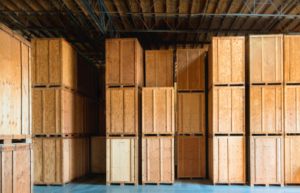Moving to a new home is exciting, but considering how to pack for a move can quickly become overwhelming. Where do you even start?
The good news is that with a clear plan and practical steps, packing to move doesn’t have to be a daunting task. In this guide, we’ll break down the packing to move process into manageable steps, showing you how to start packing to move, what to pack first, and what to leave until the end.
We’ll also give you a room-by-room packing checklist to make the process smoother and more organized.
How to Start Packing to Move
When to Start Packing For a Move
Timing is everything when considering when to start packing for a move. Starting too late creates unnecessary stress while beginning too early might mean living out of boxes longer than necessary.
Ideally, begin packing about 4-6 weeks before moving day. This timing provides ample time to sort through belongings, declutter, and pack non-essential items without feeling rushed.
Packing to Move Supplies: Boxes Room-by-Room
Before diving into packing, gathering all the necessary supplies is crucial. Must-have materials include packing tape, bubble wrap, packing paper, markers for labeling, and plenty of padding materials to keep belongings safe.
Of course, the most important moving supplies are sturdy moving boxes of various sizes. To make the packing process smoother, procure a range of small, medium, and large boxes and specialty boxes for items like clothing, dishes, and electronics.
Estimating the number of boxes needed to pack to move can be tricky. The most accurate method is by obtaining a moving box count from a professional moving consultant’s survey. However, for a general idea based on home size, check out Olympia’s guide to estimating the number of boxes for a move.
How Many Boxes Do You Need For a Move?
Which Room to Pack to Move First
When choosing which room to pack to move first, it’s best to start with the least-used spaces or the rooms that contain the most non-essential items.
Areas like the garage, attic, library, office, or playroom are typically good places to start packing to move. These rooms often house items that aren’t required in the weeks leading up to a move, making them perfect for early packing. Gradually ease into the packing to move process by tackling these spaces first without disrupting daily routines.
Which Room to Pack to Move Last
As moving day looms closer, leave the most frequently used rooms until the end. In a room-by-room packing to move method, these typically include the kitchen, bathrooms, and bedrooms.
Start by packing non-essential items in these spaces, such as décor, specialty items, and anything that’s not immediately needed. As the move approaches, gradually pack up the daily essentials like bedding, toiletries, and the most-used cooking supplies.
To make the first night in a new home more comfortable, consider preparing a “first night box.” This box contains all the essentials that will be needed right away, like a change of clothes, basic toiletries, and important documents. Learn what to pack in a moving first night box.
What Is a Moving First Night Box?
Tips and Packing to Move Checklist, Room-by-Room
Packing an entire home to move can feel like a herculean task, but breaking it down room by room makes the process more manageable.
Use these tips for packing to move each space, along with a handy room-by-room packing checklist.
Packing the Kitchen to Move Checklist
Tips:
- Use plenty of packing paper or bubble wrap to protect fragile items. Place heavier items on the bottom and lighter ones on top.
- Clean and dry appliances thoroughly before packing. Secure any loose parts.
- Use up perishable items before the move, and pack non-perishables in sturdy boxes.
- Use a sturdier dishpack box to pack the most fragile items, dishware, and glassware.
Remember to Pack:
- Dishes and glassware
- Pots and pans
- Small appliances (e.g., toaster, blender)
- Utensils and cutlery
- Cooking essentials (e.g., spices, oil)
- Dish towels and oven mitts
- Tupperware and food storage
- Cleaning supplies
- Trash bags
- Non-perishable food items
Packing Bedrooms to Move Checklist
Tips:
- Pack bedding and pillows in large boxes or vacuum-sealed bags to save space.
- Protect mattresses with a mattress bag to prevent damage during transit.
Remember to Pack:
- Bedding (sheets, blankets, pillows)
- Mattresses and mattress protectors
- Nightstands and lamps
- Jewelry and accessories
- Books and personal items
- Wall art and décor
- Mirrors (properly wrapped)
- Curtains and window treatments
- Alarm clocks and electronics
Packing Bathrooms to Move Checklist
Tips:
- Pack toiletries in a separate, easily accessible box for immediate use.
- Roll towels to save space and use them as padding for fragile items.
- Keep medications in a small, clearly labeled box to easily access.
- Pack liquids into zip-lock bags in case of a spill.
- Many cleaning supplies & bleach cannot be transportated by movers.
Remember to Pack:
- Toiletries (shampoo, soap, toothpaste)
- Towels and washcloths
- Shower curtain and bathmat
- Medications and first aid supplies
- Hairdryers and styling tools
- Makeup and grooming supplies
- Cleaning supplies
- Bathroom scales
- Toiletry organizers
- Toilet paper and hand soap
Packing the Living Room to Move Checklist
Tips:
- Label cables and cords, and pack electronics in their original boxes if possible.
- Disassemble large furniture pieces and protect them with moving blankets.
- Pack books flat in small boxes to prevent damage and make them easier to carry.
- It’s best to pack TVs in their original box, or purchase a special TV moving box.
Remember to Pack:
- Electronics (TV, gaming consoles, speakers)
- Remotes and cables
- Books and magazines
- Decorative items (vases, candles)
- Rugs and curtains
- Furniture (sofas, chairs, coffee tables)
- Wall art and mirrors
- Lamps and lighting
- Throw pillows and blankets
- DVDs, CDs, and other media.
Packing the Dining Room to Move Checklist
Tips:
- Use plenty of padding and pack china and glassware securely in dishpack boxes.
- Disassemble the dining table and wrap each piece separately.
- Pack tablecloths and napkins with similar items from other rooms.
Remember to Pack:
- Silverware and serving utensils
- Table linens (tablecloths, napkins)
- Dining table and chairs
- Decorative items (candlesticks, centerpieces)
- Art and wall hangings
- Rugs and curtains
- Wine and liquor bottles (how to move wine)
- Serving dishes and platters
Packing an Office to Move Checklist
Tips:
- Organize and label important documents and pack them in a secure, waterproof container.
- Back up computer files and pack electronics with care.
- Use small boxes and pack books flat to avoid damage.
Remember to Pack:
- Computers and accessories
- Office supplies (pens, paper, staplers)
- Important documents and files
- Books and reference materials
- Desk and chair
- Printer and scanner
- Wall art and décor
- Cables and cords (labeled)
- File cabinets and drawers
- Personal items (photos, plants)
Packing Closets to Move Checklist
Tips:
- Use wardrobe boxes to keep clothes on hangers, and pack out-of-season items separately.
- Wrap shoes in paper to protect them from damage.
- Keep smaller items like belts, scarves, and hats organized in labeled bags.
Remember to Pack:
- Hanging clothes
- Shoes
- Hats, belts, and scarves
- Handbags and accessories
- Seasonal clothing and outerwear
- Storage bins and boxes
- Luggage and travel bags
- Linens and blankets
- Jewelry and small items
- Closet organizers
Packing a Garage to Move Checklist
Tips:
- Pack tools in their original cases if available, and wrap sharp edges for safety.
- Dispose of hazardous materials properly, as most movers cannot transport them.
- Drain gasoline from lawnmowers and other outdoor equipment before packing.
Remember to Pack:
- Tools and toolboxes
- Sports equipment
- Lawn and garden tools
- Bikes and outdoor gear
- Seasonal decorations
- Hardware and fasteners
- Storage bins and shelving units
- Car care products
- Outdoor furniture and grills
Packing a Yard to Move Checklist
Tips:
- Pack plants last and transport them in person vehicles, as they are sensitive to temperature changes.
- Clean and disassemble large pieces for easier transport.
Remember to Pack:
- Plants and planters
- Outdoor furniture
- Garden tools
- Grills and BBQ supplies
- Lawn décor and ornaments
- Outdoor lighting
- Hoses and sprinklers
- Patio cushions and umbrellas
- Playground equipment
- Outdoor storage boxes
Packing a Basement and Attic to Move Checklist
Tips:
- These areas often contain items that are not used regularly, so take time to declutter before packing.
- Since these boxes may be stored for a while, label them clearly and note any fragile items.
- Pack heavier items in small, sturdy boxes to make them easier to carry.
Remember to Pack:
- Seasonal decorations
- Extra furniture
- Storage bins and boxes
- Old documents and files
- Tools and hardware
- Sports equipment
- Holiday decorations
- Heirlooms and keepsakes
- Camping gear
Packing Checklist for Moving PDF
Download the PDF version of this packing checklist for moving:
Hire Professional Packing Services
If how to pack for a move still feels overwhelming, remember—you don’t have to do it all yourself!
Did you know that you can hire your movers to pack for you? Letting experienced movers take over means you can skip the hassle of sourcing packing materials, figuring out how to protect fragile valuables, and spending countless hours boxing up your life.
So why sweat the small stuff when you can pack up the stress and let Olympia Moving handle the rest? We have professional packing services in Boston, Washington D.C., Austin, Tampa, or Philadelphia. Contact us today to learn more about our packing options and how we can wrap up your next move.



